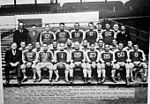Coogan's Bluff
Hamilton Heights, ManhattanHarlemLandforms of ManhattanNeighborhoods in ManhattanUse mdy dates from June 2017 ... and 1 more
Washington Heights, Manhattan

Coogan's Bluff is a promontory near the western shore of the Harlem River in the Washington Heights neighborhood of Upper Manhattan in New York City. Its boundaries extend approximately from 155th Street and the Macombs Dam Bridge viaduct to 160th Street, between Edgecombe Avenue and the river. A deep escarpment descends 175 feet (53 m) from Edgecombe Avenue to the river, creating a sheltered area between the bluff and river known as Coogan's Hollow. For 73 years, the hollow was home to the Polo Grounds sports stadium.
Excerpt from the Wikipedia article Coogan's Bluff (License: CC BY-SA 3.0, Authors, Images).Coogan's Bluff
John T. Brush Stairway, New York Manhattan
Geographical coordinates (GPS) Address Nearby Places Show on map
Geographical coordinates (GPS)
| Latitude | Longitude |
|---|---|
| N 40.8326 ° | E -73.9393 ° |
Address
John T. Brush Stairway
John T. Brush Stairway
10032 New York, Manhattan
New York, United States
Open on Google Maps








